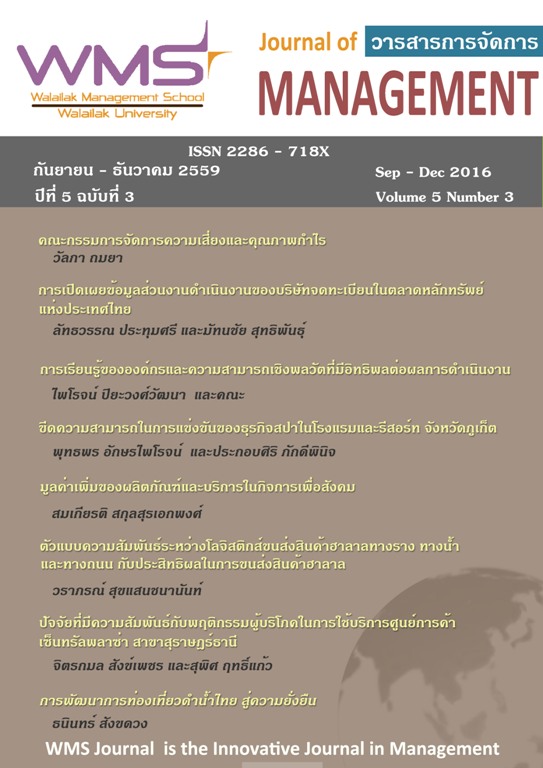Competitive Capacity of Spas in Hotel and Resorts in Phuket
Main Article Content
Abstract
Article Details
References
กรมการท่องเที่ยว. (2556). การบริหารจัดการท่องเที่ยวเชิงสุขภาพในโรงแรมและ
รีสอร์ท. กรุงเทพฯ: สำนักพัฒนาการท่องเที่ยว กรมการท่องเที่ยว.
กรมพัฒนาธุรกิจการค้า. (2553). การศึกษาสถานภาพและความสามารถในการแข่งขันของธุรกิจโรงแรมในประเทศไทย. สืบค้นเมื่อ 21 มีนาคม 2557, สืบค้นจาก http://caii-thailand.com/sites/default/files/
downloads/Hotel.pdf.
กรมสนับสนุนบริการสุขภาพ. (2551). เอกสารความรู้ ผู้ดำเนินการสปาเพื่อสุขภาพ. นนทบุรี: กระทรวงสาธารณสุข.
ชาย โพธิสิตา. (2554). ศาสตร์และศิลป์แห่งการวิจัยเชิง คุณภาพ (พิมพ์ครั้งที่ 6). กรุงเทพฯ: อมรินทร์พริ้นติ้งฯ.
ธนาคารเพื่อการส่งออกและนำเข้าแห่งประเทศไทย.
(2553). ธนาคารเพื่อการส่งออกและนำเข้าแห่งประเทศไทย. สืบค้นเมื่อ 10 กุมภาพันธ์ 2557, สืบค้นจาก http://www.exim.go.th/ doc/newscenter/40447.pdf.
นายแพทย์สมยศ ดีรัศมี. (12 กุมภาพันธ์ 2552). สธ.จัดงาน มหกรรมสปาไทยก้าวไกลสู่สากล 27 ก.พ.-1 มี.ค. ผู้จัดการออนไลน์, สืบค้นเมื่อ 21 มีนาคม 2557, สืบค้นจาก http://www.manager.co.th/Qol/ViewNews .aspx?NewsID=9520000016392.
นายแพทย์เจษฎา ฉายคุณรัฐ. (2556). ที่ปรึกษา รมว. สาธารณสุข ตรวจเยี่ยมโรงพยาบาลวชิระภูเก็ต. โอเคเนชั่น, สืบค้นเมื่อ 21 มีนาคม 2557, สืบค้น จาก http://www.oknation.net mblog/entry.php?id=853971.
พหล ศักดิ์คะทัศน์, สุรชัย กังวล และหนึ่งหทัย ตันติ สันติสม. (2555). ความเข้มแข็งของธุรกิจ สปาและนวดแผนไทยโดยชุมชนในจังหวัดเชียงใหม่. เชียงใหม่: คณะผลิตกรรมการเกษตร มหาวิทยาลัยแม่โจ้.
ราณี อิสิชัยกุล และภาสกร จันทน์พยอม. (2556). ยุทธศาสตร์การพัฒนาสปาไทยเพื่อส่งเสริมให้ เป็นสถาบันฝึกอบรมสปาในภูมิภาคอาเซียน. กรุงเทพฯ: สาขาวิชาวิทยาการจัดการ มหาวิทยาลัย สุโขทัยธรรมาธิราช.
สถาบันพัฒนาวิสาหกิจขนาดกลางและขนาดย่อม. (2556). รายงานการศึกษาขั้นสุดท้าย (Final Report) การจัดทำยุทธศาสตร์และแผนปฏิบัติการ ส่งเสริมวิสาหกิจขนาดกลางและขนาดย่อมราย สาขา. สืบค้นเมื่อ 10 กุมภาพันธ์ 2557, สืบค้นจาก http://www. sme.go.th/SiteCollectionDocuments/ สปาและบริการสุขภาพ%20_final.pdf.
สุพรรณิการ์ ขวัญเมือง และเบญจวรรณ โมกมล. (2550). ศักยภาพและความพร้อมของการท่องเที่ยวเชิงสปา จังหวัดเชียงราย. เชียงราย: มหาวิทยาลัยแม่ฟ้าหลวง.
สำนักงานส่งเสริมวิสาหกิจขนาดกลางและขนาดย่อม. (2552). รายงานการศึกษา วิเคราะห์ และเตือนภัย SMEs รายสาขาฉบับสมบูรณ์ ธุรกิจบริการเสริมสร้าง สุขภาพสปาและสังคม ปี 2552 และแนวโน้มปี 2553. สืบค้นเมื่อ 10 กุมภาพันธ์ 2557, สืบค้นจาก http://122.155.9.68/bws/images/Report_5 2/sec_spa.pdf.
Montgomery, C. A. (2012). The Strategist. London: Harpercollins.
Dranove, D. & Marciano, S. (2005). Kellogg on Strategy. New Jersey: John Wiley & Son.
Euromonitor International. (2012). Health and wellness tourism in Thailand. Retrieved May, 4, 2014. From http:// www.euromonitor.com/health-and- wellness-tourism-in-Thailand/report.
Porter, M. E. (2004). Competitive Strategy:
Techniques for Analyzing Industries and Competitors. London: Simon & Schuster.
Porter, M. E. (1977). “How much does Industry Matter, Really?” Strategic Management Journal, Summer, 15-30.
Chrissie, W. (1997). Aromatherapy. London: Bloomsbury Publishing

